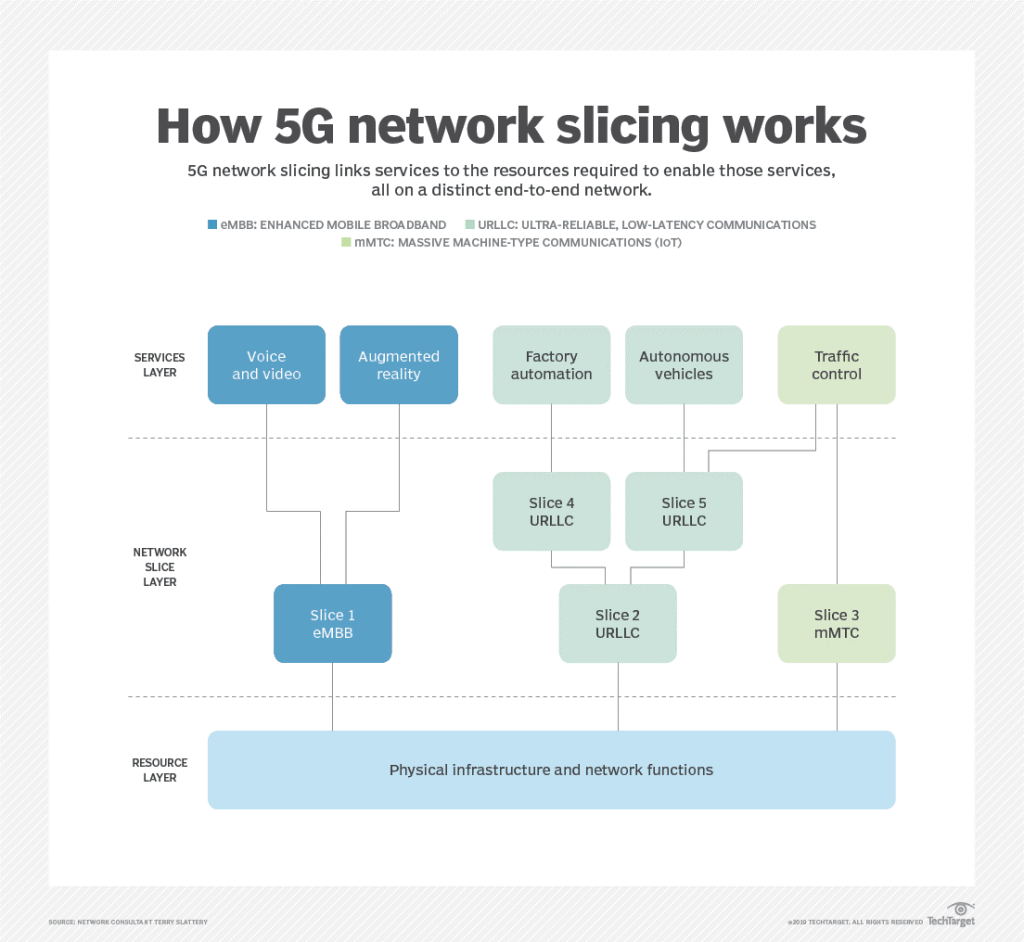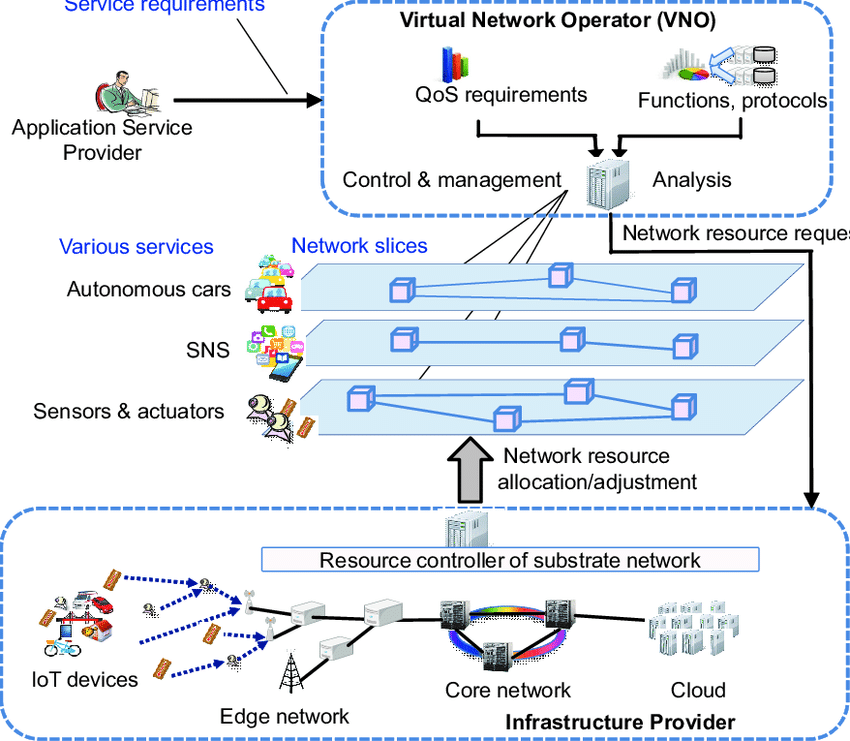Revolutionizing Telecom with AI-Driven Network Slicing

Futurism Technologies
April 8, 2024 - 6.2K
5 Min Read
Welcome to the dawn of a new era in telecommunications, where the convergence of 5G technology and Artificial Intelligence (AI) is not just reshaping, but revolutionizing the way we think about connectivity. At the heart of this transformation is network slicing, a pivotal feature of 5G networks, brought to life by the prowess of AI and Machine Learning (ML). Imagine a world where your autonomous vehicle, your 4K live stream of the World Cup, and your smart home devices all operate seamlessly on the same physical network, yet on entirely separate lanes, optimized for their unique needs. This is not the future; this is the now, enabled by network slicing. Join us as we delve into the fascinating world of AI-driven network slicing, exploring its significance, its mechanisms, and the boundless possibilities it holds for the telecom industry.

In today’s cutthroat telecom landscape, the implementation of AI-driven network slicing is not merely an enhancement but a complete overhaul of traditional network management and operation paradigms. This revolution is empowering telecom operators to offer highly customized and optimized services across a myriad of use cases, ushering in an era of unprecedented efficiency and flexibility. As we embark on this exciting journey, it’s clear that the synergy between 5G, AI, and ML is not just a step forward but a giant leap towards realizing a fully interconnected and intelligent digital world. With each virtual network slice, we’re carving out a future where technology adapts to our needs in real-time, paving the way for innovations that will redefine our digital experiences. Join us as we navigate through this groundbreaking evolution, where the possibilities are as limitless as our imagination.
The Concept of Network Slicing
In essence, network slicing is the process of creating multiple distinct virtual networks atop a single physical network infrastructure. Each of these virtual networks, or “slices,” is designed to serve a specific purpose, catering to a particular set of requirements related to bandwidth, latency, security, and reliability. For instance, a slice dedicated to emergency services can be configured for ultra-reliability and low latency, while another slice for IoT devices might prioritize coverage and energy efficiency over speed.
This bespoke approach to networking is a significant departure from the traditional one-size-fits-all models. It allows telecom operators to offer tailored services to diverse user groups and application scenarios, significantly enhancing the efficiency and versatility of the network. The implementation of network slicing is a testament to the flexibility and scalability that 5G promises, paving the way for innovative applications and services that were previously inconceivable.
Read also: How AI is Battling Telecom Churn?
The concept of network slicing is further enriched by its inherent capability to dynamically allocate and reallocate resources as demands shift. Imagine a scenario where a major event causes a sudden spike in data demand. Network slicing allows for instantaneous adjustment, reallocating resources from less critical slices to ensure uninterrupted service where it’s needed most. This level of agility and responsiveness is crucial in today’s fast-paced digital world, where user expectations and demands are ever-evolving.
Moreover, network slicing opens up a world of possibilities for innovation within the telecom sector. By creating a more adaptable network environment, telecom companies can explore new business models and services, such as offering specialized network capabilities as a service to enterprises, fostering the development of smart cities, or enhancing mobile gaming experiences with guaranteed performance levels. Each slice can be customized not just in terms of technical specifications, but also in how it’s managed and monetized, providing a fertile ground for creativity and growth in the telecom industry.
This transformative approach also signifies a pivotal shift in how network services are conceptualized, designed, and delivered. It marks the transition from a hardware-centric network architecture to a more software-driven model, where virtualization and cloud technologies play a key role. This shift not only enhances the efficiency and flexibility of network services but also significantly reduces the time and cost associated with deploying new network functionalities or scaling existing services. As we delve deeper into the era of 5G and beyond, network slicing stands out as a cornerstone technology that will enable the next wave of digital transformation across industries.
Why Network Slicing Matters?
The advent of 5G brings with it an explosion in the number and type of connected devices, each with its unique requirements. From billions of low-power IoT sensors to high-bandwidth video streaming services and latency-sensitive gaming and autonomous vehicles, the demands on telecom networks are more diverse than ever. Network slicing addresses this challenge head-on, enabling the creation of customized networks that can dynamically adapt to the needs of different services and users.
The benefits of network slicing extend far beyond enhanced user experiences. For telecom operators, it opens up new avenues for business models and revenue streams, allowing them to serve niche markets with highly specialized services. Moreover, by optimizing the use of network resources, operators can achieve significant efficiency gains, reducing operational costs while still meeting the diverse quality of service (QoS) and experience (QoE) requirements of their customers.

AI and ML: The Game Changers in Network Slicing
While the concept of network slicing is revolutionary, its execution is complex, requiring advanced technologies to manage and optimize the myriad virtual networks efficiently. This is where AI and ML come into play, acting as the brains behind the operation. AI algorithms, with their ability to learn from vast amounts of data and make intelligent decisions, are ideally suited to manage the dynamic and complex nature of network slicing.
AI-driven solutions can monitor network conditions in real-time, predict traffic patterns, and automatically adjust resources to ensure each slice meets its specific requirements. For example, an AI system might detect an upcoming surge in video traffic during a major sports event and dynamically allocate additional bandwidth to the relevant slice, ensuring high-quality streaming for all viewers.
Furthermore, AI can enhance the security of network slices, identifying and isolating potential threats before they can affect the network through AI-powered fraud detection. By continuously learning from network behavior, AI algorithms can become increasingly effective at detecting anomalies, making the network more resilient against attacks and failures.
AI and ML’s Role in Network Slicing
Complexity Management
Network slicing introduces a level of complexity previously unseen in network management. AI and ML emerge as crucial technologies to navigate this complexity, thanks to their ability to analyze vast datasets and automate decision-making processes.
Dynamic Resource Allocation
- AI algorithms excel in real-time monitoring and analysis of network conditions.
- They predict traffic patterns with remarkable accuracy, allowing for the dynamic allocation of resources to meet the varied demands of each network slice.
Enhanced Security Measures
- AI significantly bolsters the security framework of network slicing.
- It identifies and isolates potential threats in real-time, preventing them from causing widespread disruptions.
- Continuous learning from network behavior enables AI algorithms to detect and adapt to new anomalies, thereby strengthening the network’s defense against both known and emerging threats.
Automated Network Optimization
- Beyond security and resource management, AI and ML algorithms optimize network performance across slices.
- They can assess the performance of each slice against predefined parameters, adjusting configurations to maintain or enhance service quality.
- This level of automation ensures that network slicing achieves its goal of providing tailored network experiences without necessitating constant human oversight.
Predictive Maintenance
- AI-driven network slicing extends into predictive maintenance, identifying potential issues before they impact service.
- By analyzing historical data and real-time inputs, AI can predict equipment failures or degradation, scheduling maintenance to avoid downtime.
Future-Ready Networks
- The integration of AI and ML prepares networks to handle future demands with greater agility.
- As telecommunications evolve with new technologies and services, AI-enhanced network slicing will be pivotal in enabling rapid deployment and scaling of innovations.
Economic and Operational Efficiency
- AI-driven network slicing optimizes not just the technical aspects but also the economic efficiency of network operations.
- It allows operators to maximize the utilization of their infrastructure investments by catering to a diverse range of service requirements without the need for physical network expansion.
The Future of AI-Driven Network Slicing
As we look to the future, the role of AI in network slicing is set to grow even more critical. With the ongoing advancements in AI and ML technologies, we can anticipate more sophisticated and autonomous network management solutions, capable of predictive, rather than just reactive, adjustments to network conditions. This could lead to the development of self-healing networks that can anticipate failures and reconfigure themselves to maintain service continuity without human intervention.
Read also: Beyond Intelligence – The Rise of Self-Healing AI
Moreover, the integration of AI with emerging technologies such as blockchain for secure slice management and quantum computing for processing vast datasets at unprecedented speeds could further enhance the capabilities and efficiency of network slicing. These advancements hold the promise of creating not just more flexible and efficient networks but entirely new ecosystems of connected services and applications, driving innovation across industries.
Takeaway
The integration of AI and ML with network slicing stands at the forefront of the telecom revolution, heralding a future where networks are not just faster, but smarter, more resilient, and more adaptable than ever before. As we embrace the possibilities opened up by AI-driven network slicing, we move closer to realizing the full potential of 5G and beyond—ushering in a new age of connectivity that will transform industries, economies, and societies.
At Futurism Technologies, we’re excited to be part of this journey, leveraging our expertise in cutting-edge ML and AI solutions for telecom operators to navigate this brave new world. With AI-driven network slicing, we’re not just anticipating the future; we’re building it, one slice at a time.
Looking for greater efficiencies, new business models and delivering exceptional customer experiences?
Subscribe Now!
TRENDING POSTS
-
Futurism Returns to Hannover Messe 2024: Leading the Charge in Industrial and Digital Transformation
-
The Role of Smart Maritime IoT Solutions in Enhancing Maritime Safety
-
Data Integration Unlocked: From Silos to Strategy for Competitive Success
-
Navigating the Shadows: Understanding Zero-Click Attacks in the Digital Age
-
AI Reimagined: Crafting Next-Gen AI Apps with Expert Fine-Tuning
-
Explore Next-Gen Digital Solutions with Futurism at MWC 2024
-
Futurism Unleashes the Technology of Tomorrow at MWC Barcelona 2024
-
Futurism AI: Turning Ideas into Apps at Lightning-Fast Speed
-
Accelerate AI Across Your Enterprise With Futurism AI
-
Futurism to Address the Biggest Security Challenges at RSS 2022
-
Futurism at SelectUSA 2022: Steering the Next Wave of Businesses
-
Futurism to Uplift the MSP Business Community at the MSP Expo 2022
-
Futurism Sets Out to Address the Biggest Security Challenges at the RSA Conference 2022
-
5 Ways to Prepare Your Business for Digital Transformation
-
4 Ways To Win at Digital Transformation on a Shoestring Budget
-
Futurism: Empowering MSPs at the Channel Partners Conference & Expo 2022
-
Why AI in Digital Marketing is the Next Big Thing?
-
Futurism brings ‘Mobile First Digital Transformation’ to the fore at MWC Barcelona 2022
-
Cybersecurity for Rural Hospitals: How can Rural Hospitals become Cyber Smart?
-
Futurism Empowers Rural Health Care Community at the AHA Rural Health Care Leadership Conference
-
The Biggest Problem With Cybersecurity In Healthcare Sector, And How IBM QRadar Can Fix It?
-
How IBM MaaS360 is Revolutionizing Endpoint Security in the Healthcare Industry?
-
Futurism to Present its MSP Partner Program at the Channel Partners Conference & Expo 2021
-
EndPoint Security in Healthcare Matters and IBM MaaS360 Can Help
-
How AI Will Enable Faster Adaptation of Digital Transformation
-
How Is Digital Modernization Important In Supplier On-Boarding?
-
Top 10 Email Marketing Tips for This Holiday Season
-
Benefits of using ERP Software for Energy and Gas Industries

